The Abode of Madness
The long history of no man’s land, from lawlessness and desolation to hope and regrowth.

The term no man’s land comes with clear connotations of war, especially trench warfare on the Western Front. Yet the concept of ‘none man’s land’, nanesmaneslande, first appears in the Domesday Book of 1086, referring to the area that is now Hyde Park in London. The phrase as we know it today arose in the mid-14th century as nomanneslond, referring to what the Oxford English Dictionary describes as ‘the name of a plot of ground lying outside the north wall of the city of London, the site of a place of execution’. It was also used more generally to describe land that was disputed, such as an area in Herefordshire that was contested between the monasteries of Westminster and St Albans in the 1400s and, as a result, is still called Nomansland Common today. It was also used to indicate areas considered beyond the realms of the law, often associated with loss or death, such as mass burial grounds or plague pits.







